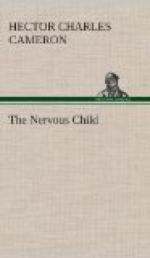The lordosis resembles the similar deformity which develops in cases of primary myopathy, when the spinal muscles have undergone complete atrophy. As in myopathy the movements are very uncertain. The children are apt to fall heavily when the centre of gravity is suddenly displaced, because their upright posture is maintained by balancing the trunk upon the support of the pelvis. The frequency and severity of the falls which these children suffer is a common complaint of the mother. The faulty posture is often associated with slight albuminuria. Its appearance is very capricious, but it is dependent to a great extent upon the assumption of the erect posture. There has been much discussion as to its explanation. It has been argued that the lordosis itself produces the albuminuria by mechanical compression of the renal vein, and it is said that albuminuria can be produced, even in the prone position, by placing the child in a plaster jacket applied so as to maintain the position of lordosis. Other observers, however, have not obtained this result. It seems most likely that the albuminuria is due to defective tone in the vasomotor musculature, comparable in every way to the defective tone in the muscles of the skeleton. We have often further evidence of vasomotor weakness. Fainting attacks are so common as to be the rule rather than the exception. Again, mothers are likely to complain of the child’s pallor and of dark lines under the eyes, especially after exertion or in the reaction which follows excitement of any sort. As a rule a blood count will not show any very striking evidence of true anaemia. The pallor is of vasomotor origin, determined by faults in the distribution of the blood from vasomotor weakness and not by deficient blood formation. Circulatory and vasomotor disturbance probably also accounts for the dyspeptic pains and vomiting which commonly accompany any emotional excitement, or follow any unusual exertion or fatiguing experience. Constipation is a common, and mucous diarrhoea an occasional, symptom. The abdomen is often pigmented. The hands and feet are usually cold and cyanosed.
The extreme nervousness of the children is the point upon which most stress may be laid in the present connection. The association of albuminuria with neurosis in childhood has been noticed by many observers. The gastric and intestinal symptoms are especially characteristic. If the condition of the children is not materially improved, and if the symptoms, both of the physical defect and of the nervous disturbance, are not cut short, we may predict that in adult age their lives will be made miserable by a variety of abdominal symptoms dependent both on the vasomotor disturbance and upon the accompanying neurosis. Now that surgery forms so large a part of our therapeutic proceedings, they may not reach middle life without being submitted to one or more surgical operations. With good management both on the physical side and on the moral or psychological side they can be made into strong and useful members of society.




